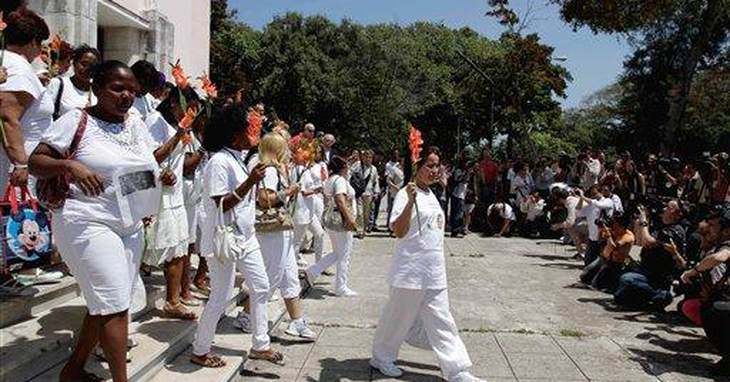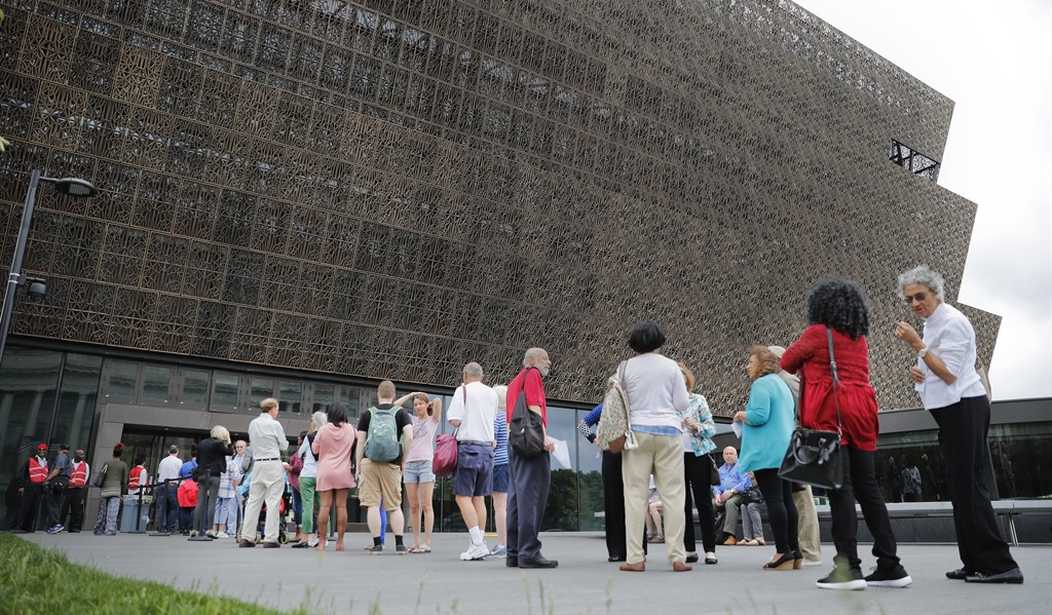Calls to defund the Smithsonian sounded across the internet on Thursday, with The Hill running a piece by Alfonso Agular calling the new Latino exhibit a “disgrace.” Agular makes potent criticisms of the exhibit’s biased and left-wing presentation of Hispanics and their histories in America, saying:
The Latino exhibit, by its own admission, reduces the identity and history of Hispanics in the U.S. to a “struggle for justice,” mostly centered on advancing a leftist agenda “on labor, education access, fair housing, and more recently, immigration and justice reform, LGBT rights…” This, of course, is nothing else but the classic culturally Marxist narrative of social confrontation.
This blatant instrumentalization of Hispanics to promote a particular ideology undermines the great diversity of ideas and political points of view that exist in the Hispanic community, while totally disregarding and denigrating the Spanish heritage and Christian roots that arguably define it.
The museum’s website describes the exhibit as:
¡Presente! A Latino History of the United States tells U.S. history from the perspectives of the diverse Latinas and Latinos who lived it and live it today. This exhibition uncovers hidden and forgotten stories, connects visitors to Latino culture, and lays the foundation for understanding how Latinas and Latinos inform and shape U.S. history and culture.
You can read more from The Hill’s piece here.
Never mind the redundancy due to the fact that the word “Latino” is already inclusive of Latinas, the exhibit’s website has the audacity to use the word “Latinx” when describing Latino identities. This is an asinine way to celebrate the heritage of Hispanics; by continually forcing them to explain how the Spanish language isn’t bigoted as suggested by the linguistic pillaging in the conquest of the “Latinx” imposition. Worse than the nonsensical moniker, is that Congress funds the “woke” museum through the National Museum of the American Latino Act passed in 2020.
🧵False assertions in the Smithsonian’s new Latino exhibit:
❌ The U.S. stole one-third of Mexico in 1848.
❌ Cubans came here seeking economic opportunity, not escaping communist barbarism.
❌ The Texas Revolution was a defense of slavery against an abolitionist Mexico.
— Heritage Foundation (@Heritage) August 11, 2022
The Heritage Foundation tweeted three falsehoods found in the new Latino exhibit. It was the “Cubans who came here seeking economic opportunity, not escaping communist barbarism,” that caught my attention. I guess this is the part where I explain that I am a first-generation American, born to a Cuban immigrant. So I did what any first-generation American would do: I texted.
“Grandma, why did you come to America? For economics or because the communists were barbaric?”
Let’s address the elephant in the room: It’s too soon to do revisionist history. The Cuban Revolution wasn’t that long ago. There are not one, but two generations of Cuban-born Americans alive and well in my family. If the Smithsonian wants to tell me the reasons why my Cuban relatives did or did not immigrate, they should wait until I can’t send a text message to ask them myself.
“To Be Cuban and to be Jewish is to be twice survivors.” —Maritza Corrales, The Chosen Island

My grandfather was a Cuban Sephardic Jew, from a lineage of Spanish Jews expelled from the Iberian Peninsula. The notion that he only immigrated post-revolution for economics and nothing else sounds a lot like a trope about Jews and money. With Fidel Castro’s impending revolution, Jewish Cubans who had immigrated from Eastern and Central Europe became increasingly concerned about religious intolerance as a result of their prior experience under Bolshevik Russia, Stalin’s Soviet Union, and the Holocaust. And, they would be right, too.
Following the 1959 revolution, 95 percent of Cuba’s Jewish community had fled to the United States by 1960. To quote Ruth Behar, University of Michigan anthropologist and a Cuban Jew whose family immigrated to the US, “The dissolution of the community was swift like a lit candle snuffed by the wind.” Soon Cuba was declared an atheist state where religious identities were to be traded for revolutionary atheism or socio-political retribution.
To further demonstrate the Cuban regime’s attitude, Jews fleeing to Israel received a designation on their passport as “repatriated” to their home country. Beyond the nationalization of private properties, economic impacts of abject theft, and the severe restriction of religious practice, the comrade-nationalist dogma didn’t fit with the autonomy of the Jewish communities and identity.
Jewish history, including the rejection of the U.S.S. St. Louis carrying 959 nearly all Jewish refugees from Nazi Germany into Cuba, and resulting in 254 passengers dying in the Holocaust, would indicate that Cuban Jews rightfully had concerns with Castro’s revolution aside from economic opportunity.
Crude Cuban History

While viewing the Smithsonian’s online Latino exhibit I came across the immigration story of Cubans who used a raft to travel to the US in the early 90s. The museum has the raft, constructed from styrofoam, tar, and plastic sheets on display as an artifact. The website even offers the ability to explore the raft as a 3D image.
I found myself conflicted, distressed, and polling those around me as to what they thought of this inclusion in the exhibit. While I do acknowledge this is someone’s immigration story and it demonstrates aspects of immigration policy, human ingenuity, and Cuban plight, I still found myself searching for how to describe my opposition to the representation afforded to Cuban Americans in the exhibit.
I found relief when I landed upon the word: “Reductive.” Of all the histories on the island and the unique cultural creations they breed, from Santaria to conga, of all the contributions Cubans have made to America, from politics to pop culture and, of all the revolutionary-era artifacts that could have been presented, I am instead shown a styrofoam raft and told this is our collective Cuban-American heritage. On display in DC, and online in 3D format, I am offered a crudely constructed raft, shadowed by the same desperation of Elian Gonzalez’s mother even though this is not representative of the periods and means of the mass exodus from Cuba. Most Cuban exiles didn’t float on rafts, though.
Styrofoam rafts are not the height of Cuban legacies, rather they are merely a symptom of bad government policies. The suggestion that Cubans only fled for economic reasons, coupled with the raft artifact constructs a full lie about what freedom means and what human rights atrocities continue in Cuba.
Par For The Course

The Latino exhibit doesn’t mention Fidel Castro once or other historically relevant Latin American dictators. It does make criticisms of Batista, and capitalism. To drive the point the Smithsonian presents a photo of BLM activists in Puerto Rico under a heading about what unites Latinos.
I wish I could say that I am surprised that our histories are ironically presented as tools for leftist propaganda. I wish I could say I was blindsided by the government funding politicized rhetoric. I wish I could say I’m shocked that promises of “fairness” made during the passage of the National Museum of the American Latino Act were brazenly broken. But, I’m not surprised, blindsided, or shocked by any of this. For the children of Cuban immigrants, it’s par for the course.
Last year my legislature in Nevada passed a law on party lines that changed the educational standards to reflect “culturally competent” education. I gave a scathing public opposition to the bill:
There is an entire community of Cubans here in Las Vegas. The history and plight of Cubans and how we became Americans will not be properly taught in schools under this law because the truth of the inequities and horrible governance that brought us into this Nation is not politically popular to point out. Instead, Cuba’s excellent literacy programs are popular. There is no freedom of speech, no democratic presidential elections since the 1950s, no religious freedom, no economic rights, and no eating beef. I could go on. There are six decades of Communist history the schools will not bother mentioning.
Assembly Bill 261 is designed to force-politicize cultural concepts onto children. We plainly do not trust you to teach our children these things. This law is not needed and not wanted. The WCSD just said they adopted antiracism standards, so why does it need to be State law? Assembly Bill 261 does not give more tools in the toolbox; it sets standards of what materials can be used based on checking off boxes of certain kinds of people, but definitely not Cubans like me. Please vote no on this politicized education bill.














